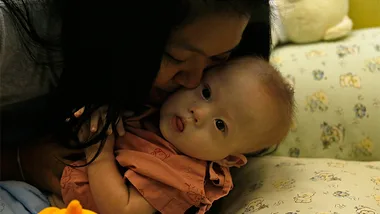When distressing or tragic events occur it’s not surprising that kids start asking questions. Tough questions that can leave parents unsure how to respond.
As news coverage of Monday’s shocking siege and hostage drama in Sydney’s CBD continues to unfold, it’s inevitable that children will hear and see some news stories that may frighten them. They may also pick-up on your emotional reaction to the events.
It’s always hard to know how to react to a situation like this – how to talk to children without creating unnecessary fear for them.
Clinicial Child Psychologist Sally-Anne McCormack says one of the issues is that children can’t generalise.
“They see it [news stories] and think that they are in imminent danger.”
“A child does not have the ability to objectively step back and realise that they are not exposed to any immediate threat.”
Senior psychologist Susie Bourke from the Australian Psychological Society said children don’t understand time and place in the same way that adults do.
“When stories are repeated over and over in the news they’re not able to have the perspective that these events aren’t next door or repeatedly happening,” she said.
“Exposure to these stories can actually stay in a child’s mind for some time. These stories can pop-up and be distressing for them into the future.
“It’s important for parents to reassure children that they are safe, their parents are safe, and the people they know are safe.
“By and large the world is a safe place, people are usually good, and life is worth living. Parents should reassure their children of this so that they feel good about being alive and can feel safe and secure.”
In an article for the Child Study Center, part of the New York University Langone Medical Center, leading child trauma experts Dr Marylene Cloitre and Dr Robin F. Goodman offered advice on talking to kids about frightening events.
Fear in young children
When young children hear discussions about bad news that they are usually most concerned about being separated from their parents. Reassure your children that they are safe and that the police and world leaders are working to keep everyone safe. Also remind them that their everyday life will go on as normal.
They recommend maintaining routines and structure for children as it is “reassuring to children and helps normalise an event and restore a sense of safety.”
But they warn to be careful to not dismiss your child’s fears.
“Exploring the issues and positive ways of coping help children master their fear and anxiety.”
Consider their personality
Some children’s personalities and temperaments may mean they are more frightened than others when hearing unsettling news.
“Some children are naturally more prone to be fearful and thus news of a dangerous situation may heighten their feelings of anxiety.”
Preschoolers
Pre-schoolers are particularly sensitive to news stories, “With respect to age, preschool age children may be the most upset by the sights and sounds they see and hear.”
The reason is:
Preschoolers can easily confuse facts with their own fantasies and their heightened fear of danger.
They can become easily-overwhelmed by news stories as they don’t have the ability to keep things in perspective, e.g. they can’t comprehend that they may be removed from any real threat.
They may find it difficult to stop their own troubling thoughts about the news.
School-aged children
But for older children the suggestion is that watching, reading, or examining the news together may be the best way to help your child process today’s news.
“It provides a ready forum for discussing the topic and parents become informed about how the children processed the material and how they feel about it.”
It’s important to debrief with them, and explain that they are not immediately in any danger. Here’s why:
A child this age watching a snippet of a unsettling news story may relate it to a scene from a scary movie. They may believe the news is worse that it is in reality.
If they hear the same incident be repeatedly reported they may believe that more people are affected than there really is.
The heightened sense of fear that is often relayed in graphic news reports can make a threat feel much closer to home than is the reality. They may feel like there is danger literally around the corner.


